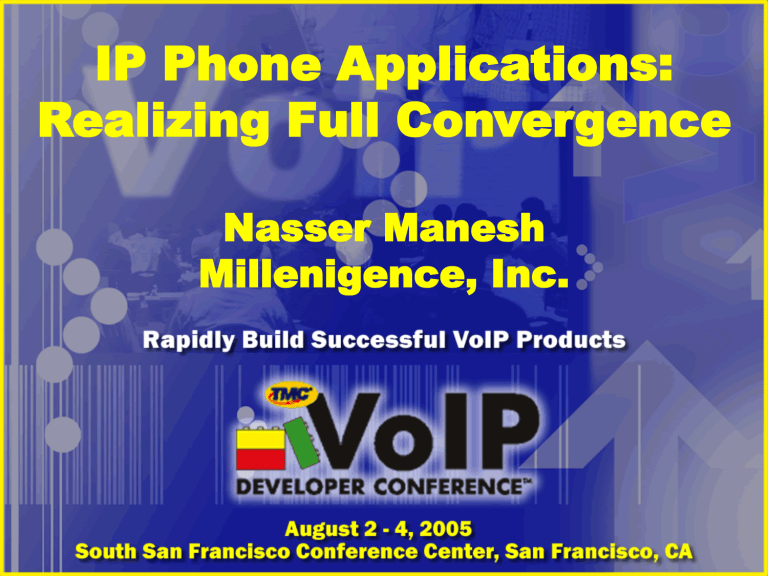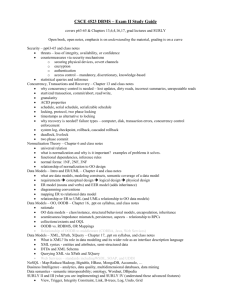IP Phone Applications

IP Phone Applications:
Realizing Full Convergence
Nasser Manesh
Millenigence, Inc.
IP Phone Applications:
Realizing Full Convergence
Nasser Manesh
CTO
Millenigence, Inc.
What We Will Cover
• Defining IP Phone Applications
• Background
• Outlook
• Architecture
• Issues and Challenges
Defining IP Phone
Applications
IP Phone Primer
• IP Phones use IP for signaling and streaming of voice
• No “phone” jack – direct LAN/WLAN connection
• Major vendors are shipping more IP
Phones than traditional phones in 2005
• Cisco alone has shipped more than
5,000,000 IP Phones (May 2005)
IP Phone Applications
• IP Phone: More than just a phone!
• Dual personality: Voice and Data
• Always on, always on the network
• Applications: o
Beyond voicemail, UM, etc.
o
Use IP Phones as network terminals, integrated into business workflow
• Keyboard/keypad and screen extend the reach of data and applications to the user
Example: Health Care
Example: Time Sheet
Example: Hospitality
Background
Traditional Applications
• Voicemail, ACD, Predictive dialing, etc.
• Hanging off of PBX in old, TDM setup
• Connectivity through CTI
• Data comes only in the form of: o
IVR interaction o o touch tone or DTMF interaction
Backend processing (e.g., contact center)
• Data integration is very limited and rudimentary
Traditional Architecture - CTI
CTI Shortcomings
• Highly proprietary and closed
• Highly PBX dependent
• The end device is not present on the network
• No or limited API – mostly signal driven
• Costly to implement
From TDM to VoIP
• VoIP promised convergence
• Convergence happening at the network level
• voice and data are still two unrelated entities – no endpoint convergence
• Applications still use CTI, and suffer the same shortcomings
Outlook
Where We Are Heading
• Voice becoming commodity
• First generation applications such as VM and UM do not help differentiating anymore
• A new breed of applications is needed, with more focus on integration with business workflow
Data Applications Emerging
• Convergence should go beyond just the network – towards the endpoints
• Data and voice converge at the application level and business workflow
• End user should see both voice and data are business tools
• Like voice, data should be available anywhere, anytime, on any device
Paradigm Shift in Applications
• Data endpoints are voice aware, voice endpoints are becoming data aware.
• Communication services should be available to applications through web services
• Device limitations will no longer dictate how users interact. Both voice and data must be at user’s fingertips.
Architecture
New Application Architecture
Endpoints
• Communication device is no longer just a desktop phone: o
IP Phones o o o
Hand held devices
Cell Phones
Soft clients / soft phones
• Voice reaches all these devices, so data should also reach them ubiquitously
Ubiquitous Data Access
Voice Servers, Data Servers
• The IP PBX is now the communication hub for voice
• SIP has emerged as a standard
• Big players are rapidly moving to SIP-based call processing
• The equivalent of the IP PBX should be established for data
XML: Protocol for Data
Interchange
• Fully text based and portable
• Independent of underlying system, database, OS, etc.
• Can be used to exchange information, messages, and events
• Helps different systems/architectures communicate when used in conjunction with SOAP and XML-RPC
XML for Endpoints
• Phone vendors are converging on using
XML over HTTP as the data transport
• HTML, WML and XHTML are general forms of XML over HTTP
• WML adopted by hand held and mobile device vendors
• For more control vendors are defining XML interfaces to their endpoints
XML Data Interchange
IP PBX
XML Event XML Push
XML API/Query
XML Response
Application
XML Page
URL Access
XML Applications
• Created based on each vendor’s schema
• Generate pages using the UI objects for the particular target endpoint
• Use vendor-specific tags to control the endpoint
• Must be re-written for each endpoint!
Issues and
Challenges
State of the Market
• Different vendors, different XML schemas: o o
Cisco
Avaya o o o
Alcatel
Siemens
Polycom
• WML does not provide endpoint control tags
• Result: XML is the underlying standard, but in practice there’s no standard!
What Is Needed
• Endpoint agnostic programming – one standard set of XML tags/APIs that works on all endpoints
• On-the-fly Cross XML Translation for existing applications
• Development, Deployment, Integration platforms
Conclusion
• Next generation CTI is emerging
• Full convergence happens at application level
• Just like voice, data should be delivered to
IP Phones, hand held devices, and mobile devices ubiquitously
• Market needs to move from proprietary
XML to a standard schema

![[#CARBON-13743] Key store password of catalina](http://s3.studylib.net/store/data/007841975_2-b5be293be17dfbfd4fa5374476b625ea-300x300.png)




